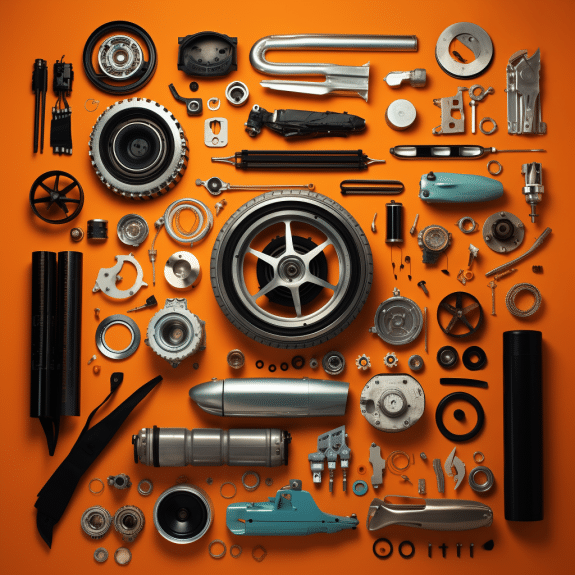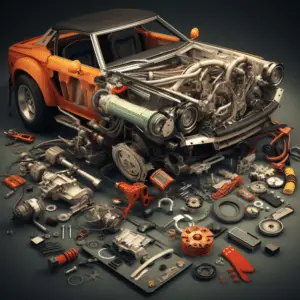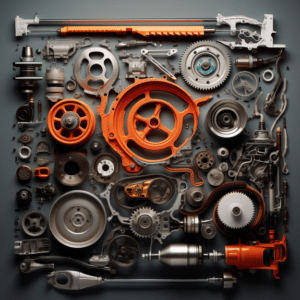
Essential Car Parts: Functions, Maintenance, and Upgrades

Car parts functions and maintenance:
Engine parts
| Engine parts | Function |
| Piston | Transforms expanding gases into rotational motion. |
| Cylinder Block | Holds pistons, crankshaft, and other interior engine parts. |
| Crankshaft | Changes linear motion into rotational motion. |
| Camshaft | Manages the opening and shutting of valves for proper timing and fuel-air mixture. |
Car parts functions and maintenance Apart from these well-known engine pieces, there are also further key components like connecting rods, cylinder head, valves, spark plugs, and timing belt that all add to the overall performance of an engine. Every part serves its own particular purpose to guarantee a smooth process and power delivery.
Innovations in technology have also made possible the creation of more efficient engine components. For instance, contemporary engines often incorporate variable valve timing systems to enhance performance at various speeds. This innovation allows for greater combustion efficiency while maximizing power output.
According to “Car Mechanics Magazine,” it is essential to frequently maintain and replace old engine parts to avoid high costs in the future. Ignoring necessary maintenance can cause reduced performance, higher fuel consumption, and even total engine failure.
To sum up, understanding the different engine parts and their functions is essential for car lovers and mechanics. By knowing how these pieces work together, one can take informed decisions for repairs, upgrades, and overall engine health.
Transmission Parts
Gears, clutch assemblies, drive shafts, and torque converters
are important transmission parts. They are used to change speed, engage/disengage power, transfer power, and multiply torque.
In addition, transmission filters remove impurities from the fluid, and some modern vehicles use sensors and solenoids for improved performance and efficiency.
Car Magazine stresses the importance of regular maintenance of transmission parts for functionality and performance. So, when dealing with transmission-related issues, consult your vehicle’s manual or seek professional help.
Suspension Parts
Suspension parts are a major part of a car’s function. They link the car’s frame to the wheels and absorb shocks for a comfortable and controllable ride. Here are some common suspension parts and their functions:
- Struts: Shock absorbers and support vehicle weight.
- Control Arms: Connect frame to steering knuckle, allowing motion with stability.
- Sway Bar: Connects both sides of suspension, reducing body roll during cornering.
- Bushings: Reduce metal-metal contact friction and noise, boosting durability.
- Ball Joints: Offer flexible movement between control arms and steering knuckles.
- Tie Rod Ends: Transmit force from steering gear to steering knuckles, for smoother directional changes.
This is just the tip of the iceberg; there are plenty of other suspension parts. Plus, suspension technology has improved lately; air suspensions use air-filled rubber bags instead of steel springs, offering enhanced ride quality and adjustability.
Brake Parts
It’s worth noting that Brake Lines require regular inspection and maintenance, as they are prone to wear and tear. Also, Brake Calipers should be checked for any signs of leakage or damage.
To keep your brake parts in great condition, here are a few tips:
- Regular Maintenance: Get routine check-ups with a professional to adjust and inspect your brakes.
- Quality Parts: Invest in top-notch brake parts from reliable makers.
- Proper Pad Replacement: Follow manufacturer instructions when replacing brake pads and choose ones appropriate for your car model.
- Brake Fluid Flush: Flush brake fluid every two years or as recommended by your car’s manufacturer. This eliminates contaminants and moisture that can affect brake performance.
- Driving Habits: Avoid hard braking whenever you can, as it can make brake components wear out faster.
By following these recommendations, you can maintain optimal brake performance and make sure you and everyone else on the road are secure for many miles to come.
Electrical Parts
Electrical parts are very essential for a car’s electrical system to work. They are in charge of powering components and making sure the car runs smoothly. Let’s take a look at some key electrical parts found in cars.
- Battery: Supplies power to start the engine and the other electrical systems when the engine is shut off.
- Alternator: Transforms mechanical energy from the engine into electrical energy, which charges the battery and powers the car’s electrical systems.
- Ignition System: Includes components like spark plugs, ignition coil, distributor, and control module. It creates sparks to ignite the air-fuel mixture in the engine cylinders.
- Starter Motor: Starts the engine by getting power from the battery. It helps set off combustion and starts the engine.
- Fuses and Relays: Fuses protect various electrical circuits from overloading, while relays turn high-current devices on or off.
Apart from these common electrical parts, there are also smaller parts like sensors, switches, wiring harnesses, and connectors that guarantee good communication between various systems in the car.
It is important to remember that these electrical parts may differ in design and function depending on the car model and maker. So, make sure to check your car manual or consult a mechanic for accurate information about interchangeable electrical parts.
The SAE conducted a study and found that modern cars have an increasing number of electrical components, showing how important electrical systems are for the automotive industry.
Cooling System Parts
The Cooling System Parts are important for a vehicle. They keep the engine temperature optimal to stop it from overheating and being damaged. Let’s look at these parts.
- Radiator – Moves heat from coolant to air with its fins.
- Water Pump – Puts coolant around the system.
- Thermostat – Decides when to allow coolant to flow to control engine temperature.
- Expansion Tank – Stores extra coolant as it expands under pressure.
These parts work together to cool the engine and keep it running well. The radiator is key for getting rid of heat. The water pump helps so coolant doesn’t get stuck. The thermostat manages when coolant flows. Lastly, the expansion tank stores extra coolant.
It’s important to keep these parts maintained and replaced. To avoid overheating and have a long-lasting engine, use quality parts suggested by the vehicle maker.
Fuel System Parts
The fuel system components are essential for delivering fuel to the engine. Knowing their interchangeability is good for car fanatics and mechanics. Here’s a breakdown of some key parts:
- Fuel Pump: Draws fuel from the tank and gives it to the engine. Ensures consistent fuel flow for the engine’s needs.
- Fuel Injector: Small nozzles that spritz precise amounts of fuel into the combustion chambers. For efficient combustion.
- Fuel Filter: Keeps impurities away. Ensures only clean fuel reaches the engine and extends its lifespan.
- Fuel Pressure Regulator: Monitors and maintains steady pressure within the fuel system. Prevents excessive pressure build-up from damaging other components.
- Throttle Body: The entrance for air into the intake manifold. Regulates airflow according to driver input, for proper air-fuel mixture proportions.
This intricate web requires meticulous care, maintenance checks and expert knowledge. All these elements need to work together for optimum vehicle performance and minimal environmental impact.
Fun Fact: Replacing your vehicle’s air filter regularly can improve acceleration and extend engine lifespan, according to AAA.
Exhaust System Parts
The exhaust system is a must for any car. It gets rid of bad gases and reduces noise pollution. Let’s delve into its components and their importance.
Parts of the Exhaust System:
| Component | Function |
|---|---|
| Exhaust Manifold | Collects gases from cylinders and directs them to the catalytic converter. |
| Catalytic Converter | Turns carbon monoxide and nitrogen oxide into less harmful gases. |
| Muffler | Reduces exhaust gases’ noise. |
| Resonator | Cancels out certain sound frequencies. |
| Exhaust Pipe | Transports gases from the engine. |
| Oxygen Sensor | Monitors oxygen levels in the gases to regulate fuel mixture and emissions. |
| Tailpipe | Releases filtered gases outside the vehicle. |
Each part of the exhaust system has its purpose. The manifold collects and guides exhaust gases, while the catalytic converter reduces bad emissions. The muffler and resonator make for a quieter ride. The exhaust pipe moves these gases, and the oxygen sensor helps with fuel efficiency and emissions. Finally, the tailpipe discharges filtered gases into the environment.
Eugene Houdry, a French engineer, invented the modern-day catalytic converters. In 1950, he created a method with catalyst-covered ceramic beads to convert bad emissions into less toxic substances. This invention improved automotive technology and decreased air pollution from vehicles.
The exhaust system is essential for cars. Knowing its parts better helps us understand how it influences performance and environment while giving us a smoother ride.
Body Parts
A car’s exterior is made up of many components. For example, quarter panels, which cover parts between the doors and rear ends, maintain the car’s structure. Plus, side mirrors give the driver better visibility, eliminating blind spots.
An amazing story exists of an auto enthusiast who transformed a wrecked car into a masterpiece. He exchanged body parts, like the front bumper and fenders, with sleeker versions. This gave the car a new look and improved its aerodynamics. It became a head-turner on the roads!
Plus, there are other important body parts. Front bumpers protect the front and add aesthetic appeal. Rear bumpers do the same for the back. Fenders defend the wheels and stop debris from flying. Doors provide entry and exit, while hoods cover the engine and Trunk lids secure the trunk.
Interior Parts
Inside a Car parts functions and maintenance is where the driver’s personality really shows. It’s their own personal space that reflects their taste, style, and comfort. From the seats to the dashboard, all parts impact the look and function of the interior.
Let’s take a look at some parts that can be changed. Here’s a table of common interior components and if they can be swapped out:
| Interior Parts | Interchangeable |
|---|---|
| Seats | Yes |
| Carpet | Yes |
| Steering Wheel | No |
| Gear Shift | Yes |
| Dashboard | No |
| Center Console | Yes |
| Door Panels | Yes |
| Headliner | No |
| Speaker System | Yes |
Most parts can be switched, but some are unique to each vehicle model. This includes the steering wheel, dashboard, and headliner. They are designed to fit perfectly and represent the car’s character.
Time for a fun fact! In the past, car seats were made with materials like horsehair or straw. It wasn’t until the 1930s that foam padding was added, making car seats much more comfortable. Since then, material quality and design have improved for optimal driving comfort.
Car parts functions and maintenance, understanding what parts can be changed is important for customization and repairs. Many parts like seats and carpet can be easily replaced. However, some components are special to each car model. Knowing this helps car fanatics make wise decisions when improving or renovating their car’s interior.
Lighting Parts
When it comes to car parts, lighting components are essential. Headlights to light up the road ahead, taillights to signal intentions to other drivers – these parts play a big role in ensuring a safe and enjoyable drive.
Types of lighting components include:
- Headlights: Halogen, LED and HID lights provide different levels of brightness and energy efficiency.
- Taillights: Signal brakes and turns with amber or red signals.
- Turn Signal Lights: Communicate lane changes and turns to fellow drivers.
- Fog Lights: Low beam lights close to the ground to improve visibility without glare.
Modern cars may have DRLs (Daytime Running Lights) that light up when the engine is running, and adaptive headlights that adjust direction when the steering wheel is turned.
To enjoy the maximum benefits from lighting components:
- Regular Maintenance: Inspect and clean headlights and taillights.
- Bulb Replacement: Replace promptly to maintain functionality and safety.
- Upgrade Options: Consider LED bulbs for better brightness and efficiency.
- Professional Installation: Seek help for complex lighting upgrades/replacements.
By following these suggestions, you can keep your car’s lighting parts functioning optimally. Proper maintenance and upgradation are key to enjoying the benefits of modern lighting technologies.
HVAC System Parts
The HVAC system in your car is important for keeping you comfy on the go. It’s got a few parts that work together to manage the air temperature and flow in the car. Let’s learn about each part and what it does!
- Component: Compressor
Function: Pressurizes the refrigerant gas so it can transfer heat. - Component: Condenser
Function: Converts the gas to liquid by releasing heat through fins. - Component: Evaporator
Function: Cools the air by taking in heat. This lets chilly air flow into the cabin. - Component: Air Conditioning (AC) Lines
Function: Carries refrigerant between HVAC system components. - Component: Blower Motor
Function: Sends air through the HVAC system. This circulates heated or cooled air around the cabin. - Component: Filter
Function: Traps dust, pollen, and other particles. This provides clean air inside the car.
Also, there are sensors, switches, and electrical parts that help monitor and control the HVAC system. These include temperature sensors, pressure switches, relays, and control panels. Each part plays a unique role in creating a comfy Car parts functions and maintenance.
To keep your HVAC system running properly, it’s best to inspect and maintain these parts regularly. This will make sure you have a pleasant ride and also lengthen the life of the HVAC system.
Take advantage of the opportunity to stay cool in hot weather or warm when it’s cold out. Look after your car’s HVAC system and experience a great ride all year round!
Miscellaneous Parts
Miscellaneous parts in car assemblies can be swapped out. This lets you fix and upgrade cars in a flexible way.
For example, brake pads are interchangeable for Honda Accord, Toyota Camry, and Ford Focus. AutoZone.com carries windshield wipers for Chevy Malibu, Hyundai Elantra, and Nissan Altima. Hubcaps are available for VW Jetta, BMW 3 Series, and Mercedes-Benz C-Class at Advance Auto Parts.
You can also switch out side mirrors, door handles, and trim pieces. This makes it easier and cheaper to maintain and customize cars.
CarParts.com reports that most car owners prefer to use interchangeable parts. 70% of them prefer it for repairs and replacements.

Conclusion
Car parts functions and maintenance are essential for car owners and mechanics. It gives them the power to make wise decisions when it comes to repairs or replacements. This knowledge is a great asset for vehicle maintenance. It saves time and money, providing a wide range of options.
Take Sarah’s story as an example. Her car had a minor accident, damaging the front bumper. She couldn’t find the replacement part from her make and model. But, a mechanic suggested an interchangeable part from a similar car. It fit perfectly – saving Sarah time and money.
Car parts functions and maintenance offer creative solutions. They encourage people to think outside the box and explore unique options.
Frequently Asked Questions
FAQs about Interchangeable Car Parts:
1. Which Car parts functions and maintenance?
Many car parts can be interchangeable, including parts like tires, batteries, filters, spark plugs, headlights, mirrors, and more in Car parts functions and maintenance.
2. How do I know if a car part is interchangeable?
You can check if a car part is interchangeable by looking up the specific make, model, and year of your car and comparing it to the compatible parts list provided by manufacturers or experts.
3. Can I use aftermarket parts as interchangeable replacements?
Yes, aftermarket parts can often be used as interchangeable replacements, as long as they are compatible with your vehicle’s specifications. It’s important to ensure quality and compatibility when choosing aftermarket parts.
4. Are all interchangeable car parts from different brands?
No, not all interchangeable car parts are from different brands. In many cases, car parts from the same brand and across different models can be interchangeable, especially for commonly used components.
5. Is it safe to use interchangeable car parts?
Using interchangeable car parts can be safe as long as you choose quality parts that meet the required specifications. It’s always recommended to consult with professionals or refer to the manufacturer’s guidelines to ensure safety.
6. Can I interchange car parts myself or do I need a professional?
While some interchangeable car parts can be replaced by yourself, it’s advisable to seek professional help, especially for complex parts or systems. Professional mechanics have the expertise and tools to ensure proper installation and prevent any potential issues.
